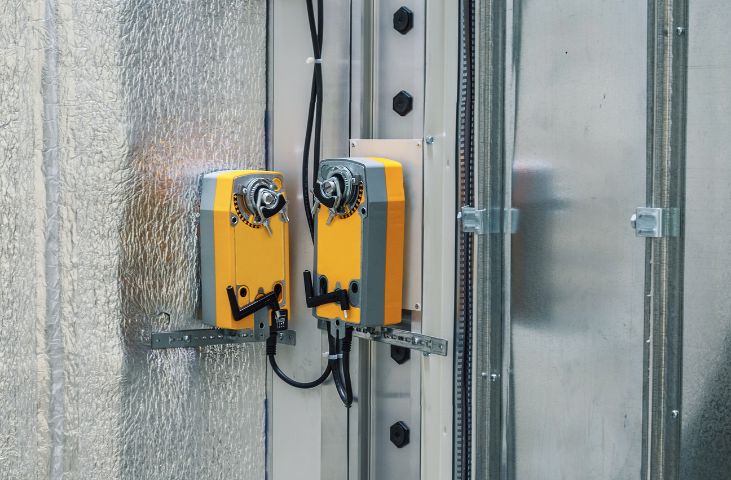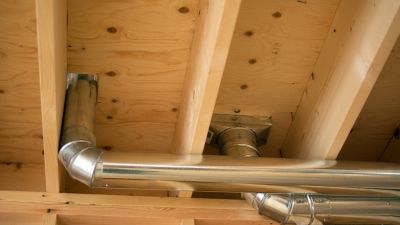How do fire dampers prevent the spread of fire?

Estimated reading time: 5 minutes
How Do Fire Dampers Prevent the Spread of Fire?
Ensuring the safety of both individuals and property in any building is important and this includes implementing fire safety measures. Buildings often include systems for heating, ventilation and air conditioning (HVAC), which feature ducts for the distribution and extraction of air. These ducts play a key role in maintaining indoor air quality and a comfortable environment. However, they can also become key areas that enable fire to spread. To mitigate this, devices called fire dampers are installed within the ductwork. Fire dampers prevent the spread of fire by automatically closing off air passages, thereby preventing the movement of flames, smoke or harmful gases.
This article looks at how fire dampers prevent the spread of fire, explores what they are, reviews the advantages of using them in HVAC systems and the UK regulations governing their use.

How do Fire Dampers Prevent the Spread of Fire?
Fire dampers prevent the spread of fire within a building’s ventilation system. These fire safety devices include several elements:
- Frame: The frame of the damper is usually a rectangle or square and is made from materials that can withstand high temperatures, such as galvanized or stainless steel.
- Blade: Positioned within the frame, these flat panels can move to open or seal off the damper, stopping the spread of fire and smoke.
- Fusible Link or Actuator: The fusible link or actuator is the operational mechanism of the fire damper, triggering its closure during a fire:
- Fusible Link: Inside the damper, this metal alloy melts at a specific temperature (typically around 74°C), which then closes the damper blades.
- Actuator: Electronic or pneumatic actuators are devices that prompt the blades to shut, activated by the building’s fire alarm or fire protection system.
- Fusible Link: Inside the damper, this metal alloy melts at a specific temperature (typically around 74°C), which then closes the damper blades.
Buildings may also employ dual-purpose fire and smoke dampers that can detect both temperature increases and smoke presence.
Benefits of Fire Dampers Preventing the Spread of Fire
Installing fire dampers in HVAC systems brings many advantages, including:
- Reducing the extent of damage to the property and protecting its contents.
- Extending the amount of time for workers to evacuate safely, while also assisting firefighting efforts in managing and extinguishing fires more effectively.
- Maintaining clear evacuation routes, like hallways and staircases, so they are free from smoke, ensuring visibility and breathable air.

Compliance with Building Codes and Regulations
Fire dampers have to be correctly installed, maintained and tested by qualified technicians to ensure they remain in good working order and comply with the latest building and fire safety regulations.
These key regulations and building codes for fire dampers include the following:
- Building Regulations 2010 (England and Wales) – Approved Document B (Fire Safety): This guideline refers to the role of fire dampers in preventing the spread of fire through HVAC ducts.
- The Regulatory Reform (Fire Safety) Order 2005: This fire safety order mandates the ‘responsible person’ to conduct a fire risk assessment and implement necessary fire safety measures, which may include fire dampers.
- BS 9999:2017 – Fire Safety in the Design, Management and Use of Buildings: BS 9999 offers advice on designing, managing and using buildings to ensure fire safety for all occupants. It specifies requirements for fire dampers’ installation, inspection, testing and maintenance within a building’s ventilation system.
- BS EN 1366-2:2015: Fire Resistance Tests for Service Installations: This European Standard outlines the procedures to assess fire dampers’ fire resistance.
- BS 9990:2015 – Non-automatic Fire-fighting Systems in Buildings Code of Practice: Primarily focusing on fire-fighting systems, BS 9990 also covers building design and construction related to fire safety, including the use of fire dampers.
- HVCA DW/145: Issued by the Heating and Ventilating Contractors’ Association, this document provides best practices for the installation, maintenance and testing of fire and smoke dampers.
- Manufacturers’ Installation Instructions: This type of documentation details the testing conditions and installation requirements for dampers to ensure they work correctly.
Enforcement
It is the responsibility of building owners and managers to guarantee that fire dampers are properly installed, regularly maintained and inspected in line with the above guidelines and legislation. Local building control agencies and the Fire and Rescue Service are typically in charge of enforcing these regulations. Non-compliance with these regulations can lead to legal action, which might include penalties or orders to undertake corrective measures.
To conclude, the saying ‘prevention is better than cure’ is especially relevant in the context of fire safety, where fire dampers play an important role in proactive preventative fire safety measures.
It is useful to understand fire dampers and their role in fire safety, especially if you work in building management, construction or maintenance. Our approved and accredited online Fire Marshal/Warden Course for staff or face-to-face Fire Marshal/Warden Courses can help you understand fire safety and ensure you are compliant with fire safety regulations.
If you would like additional information, you can get in touch with our friendly customer service team by calling us on 01327 552160, emailing us at hello@smarthorizons.co.uk, getting in touch via live chat or filling in our web contact form.
